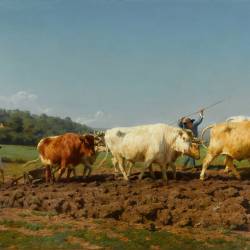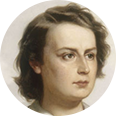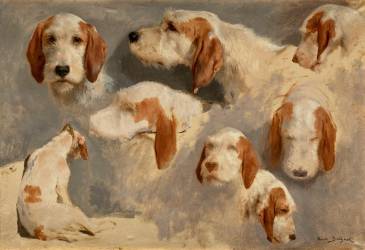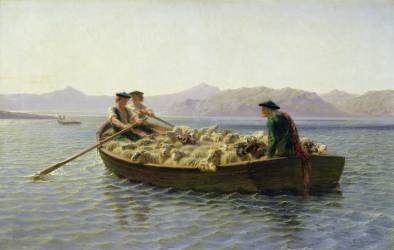Artwork of Rosa Bonheur canvas prints & artprints
A specialist in animal art and naturalistic painting, Rosa Bonheur is one of the women painters whose talent and freedom have left their mark on art history. With her independence, precise brushstrokes and unrivalled technical skills, her work impressed her contemporaries, and her fame quickly spread beyond France to the rest of Europe and the United States.
Discover the finest paintings by this famous late 19th-century artist, including her oil on canvas "Ploughing Nivernais", her first major critical success at the 1849 Salon; the oil painting "Le Marché aux chevaux", her most famous work, which brought her worldwide recognition; and "Tête de Lion", a work that bears witness to her passion for wild animals.
Treat yourself to a reproduction of Rosa Bonheur, the famous painter and icon of today's art and feminist movement, and discover her biography.
Rosa Bonheur biography
A youth marked by painting for Rosa Bonheur
Born in 1822, Marie-Rosalie Bonheur, better known as Rosa Bonheur, was born into a bourgeois family, her mother having been adopted by a successful Bordeaux merchant. Rosa Bonheur's father, Raymond, was an artist, landscape painter and accomplished portrait painter, and she, like the rest of her siblings, was drawn to a career in the arts. The Bonheur family became particularly renowned in French painting, with Rosa's sister Juliette and her brother Auguste, who also became a famous landscape painter of the period, as well as in sculpture with her brother Isidore. While Rosa's brothers may have been trained at the École des Beaux Arts, for Rosa and her sister, their painting training came exclusively from her father. This is how he trained his daughters, who dedicated their first brushstrokes to naturalist painting, but also to the doctrines of Lamennais, advocating the presence of a soul in animals, which led Rosa to specialize in animal reproductions. In 1829, Raymond Bonheur, a follower of Saint Simonism and emancipation through industrialization, moved his family from Bordeaux to Paris. It was in Paris that Rosa lost her mother at the age of 11, and where, at 14, she met Nathalie Micas, with whom she was inseparable until the latter's death.
A dazzling artistic career: rapid recognition of Rosa Bonheur's work
After several years of training with her father, Rosa Bonheur decided to take part in her first exhibition, at the Salon National de Peinture et de Sculpture in 1841, aged just 19. From then on, the animal painter impressed the contemporary artists of her time and collectors alike, with her totally mastered academic painting, her strikingly realistic depiction of the hues and reliefs of the animals' coats, their movements and the surrounding nature. At the 1843 Salon, the young Rosa Bonheur was awarded a 3rd class medal, and she did even better at the 1848 edition, winning a 1st class medal at just 26 years of age, with her painting "Bœufs et Taureaux, Race du Cantal". This recognition opened the door to state commissions, and in 1849 she painted the animal painting "Labourage Nivernais", a resounding success in the art world, which was exhibited at the Musée du Luxembourg, before joining, after her death, the Musée du Louvre and then the Musée d'Orsay. Tired of Parisian life, the painter made several trips to Auvergne and the Pyrenees between 1843 and 1850, and on her return, she was a regular visitor to the Paris horse market. Many sketches and studies emerged from this period, including her most accomplished work, "Le Marché aux chevaux", painted over a period of 3 years and exhibited at the 1853 and 1855 Salons. This realistic painting with its animal themes once again impressed the painters and critics of the time, and became a pictorial benchmark in realist artistic movements and in academic art in general. At a time when the Impressionist movement was struggling to gain recognition at the end of the 19th century, and classical and romantic painting were struggling to distinguish themselves, this gigantic painting won consensus and unrivalled success. Rosa Bonheur's brushstrokes and her reputation crossed the Atlantic, and she was recognized as one of the most prominent animal and female artists of her time.
Rosa Bonheur's installation in Seine-et-Marne
On the strength of her new-found fame, Rosa Bonheur presented her work around the world, via collectors and art dealers who distributed her paintings in Europe and across the Atlantic, as well as at various exhibitions, including the 1855 World's Fair and the 1867 World's Fair in Paris. Later, she even took part in the Chicago World's Fair in 1893, seeing her paintings exhibited in the Chicago Museum of Fine Arts. Close to the Parisian bourgeois milieu, Rosa Bonheur, still followed by Nathalie Micas, moved into a château in By, near Thomery and the Fontainebleau forest, in 1860. In her château, she set up her studio, and continued to paint paintings and portraits, always with an animal theme. She also developed a passion for wildlife, and began sketching canvases and sketches such as her famous "Lion's Head" portrait. Her passion for the animal world was also materialized by the creation of a veritable menagerie, including all types of beasts, from domesticated to wild animals. In the 1860s, Rosa Bonheur also became close to Napoleon III and Empress Eugénie, rulers of the Second Empire, when she was invited to Fontainebleau by the imperial family. At the hands of the Empress Eugénie herself, she became the first woman artist to receive the Légion d'honneur in 1865, following in the footsteps of such great male painters as Ingres and Corot a few years earlier. In 1889, Rosa Bonheur's lifelong companion Nathalie Micas passed away, after more than 50 years of companionship. The same year, she welcomed the famous buffalo hunter and founder of the Wild West Show, Buffalo Bill, whom she immortalized in a portrait that is now famous. It was during this visit that she met Anna Klumpke, an American artist who worked as a translator. The two women struck up a close friendship, living together at the Château de By until Rosa Bonheur's death from lung congestion in 1899.
Rosa Bonheur's artistic and feminist legacy
Although Rosa Bonheur's work gradually fell into oblivion during the 20th century, to the benefit of Impressionist painting, before being brought back into the limelight recently, her pictorial style based on animal art won over the contemporary artists and critics of her time, and her paintings, engravings, and other sculptures are now exhibited all over the world, from France, at the Musée d'Orsay or in the permanent collection of the Château de By near Fontainebleau, to the United States, at MoMA or the Saint Louis Art Museum, via numerous museums in Europe such as the National Museum in Warsaw or the Museum of Amsterdam. But if Rosa Bonheur remains a well-known figure to this day, it's also because of her lifestyle, which inspired numerous feminist movements. Exposing her femininity was never at the heart of Rosa Bonheur's preoccupations. While she wore her hair short for most of her life, she was also quick to apply for a cross-dressing permit, which was compulsory at the end of the 19th century, so that she could wear the pants she needed to attend the various horse fairs. Although naturally conservative in her political ideas, she quickly demonstrated her emancipation, living in concubinage with two women during her lifetime, breaking away from the forbidden École des Beaux-Arts to learn almost entirely on her own, with the advice of her father, and exhibiting at the Salon de la peinture et de la sculpture on several occasions, art being a rather masculine milieu at the time. The first female artist to be awarded the Légion d'Honneur, she is also considered the equal of men by her peers, and has even been compared to illustrious artists such as Géricault. Her artistic heritage, her freedom and the influence she had on painting have inspired many women painters, as well as movements advocating emancipation.
Learn more about the life and the works of Rosa Bonheur.





































































































